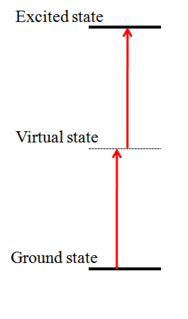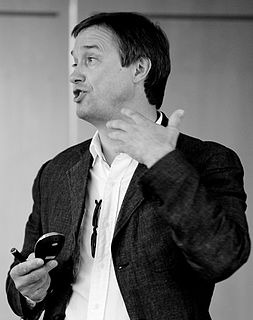Background
In 2000, Professor Mark G. Kuzyk of Washington State University calculated the fundamental limit of the nonlinear-optical susceptibility of molecules. The nonlinear susceptibility is a measure of how strongly light interacts with matter. As such, these results can be used to predict the maximum attainable efficiency of various types of optical devices. [1] [2]
For example, Kuzyk's theory can be used to estimate how efficiently optical information can be manipulated in an optical fiber (based on the Kerr effect), which in turn is related to the amount of information that a fiber-optic system can handle. In effect, the speed limit of the internet is intimately linked to the Kuzyk limit.
One peculiar finding is that all molecules that have ever been measured appear to fall below the Kuzyk limit by about a factor of 30. This factor-of-thirty gap between the fundamental limit and the best molecules is called the Kuzyk quantum gap. Nobody understands the cause of this gap, but there is no reason to believe that it is of a fundamental nature. It is therefore likely that new approaches to synthetic chemistry may find ways to make better molecules. While the gap is breachable, the Kuzyk limit is not. Given that the Kuzyk limit is based directly on quantum mechanics, a breaching of the limit would mean that there are problems with quantum theory. [3] [4]
Applications
Recently, researchers have been using nanotechnology to link molecules together to increase the nonlinear susceptibility. Since the connected molecules have more electrons, collective motions of these electrons yield enhanced nonlinear response. Since calculations show that the Kuzyk limit increases faster than linearly, it is best to link together as many molecules as possible. Researchers have made a material of interconnected fullerenes that appear to breach the Kuzyk quantum gap. However, if all electrons are correctly counted, then the gap may not have been breached. In either case, the absolute value of the nonlinearity achieved is impressive, and these kinds of materials may some day supercharge the internet. [5]
The nonlinear susceptibility is the fundamental material property that is the basis of many other important applications. Nonlinear optical materials can be used to convert light to shorter (bluer) wavelengths, which can be focused to a smaller spot size (the minimum possible beam size is proportional to the wavelength.) Shorter wavelength light sources would hence yield higher density optical recording media (such as DVDs and CDs). Other applications include tunable light sources, image recognition systems and adaptive optics.
Kuzyk's calculations can be used to predict the behavior of optical devices, guide synthetic chemists to make better materials, and to gain a deeper understanding of how light interacts with matter. This process is leading to many interesting advances in new material synthesis paradigms, which should make new types of photonic devices possible.
Perhaps most importantly, the Kuzyk Limit can be used to calculate the intrinsic hyperpolarizability, which is a scale invariant quantity that can be used to compare molecules of different sizes.

A laser is a device that emits light through a process of optical amplification based on the stimulated emission of electromagnetic radiation. The word "laser" is an acronym for "light amplification by stimulated emission of radiation". The first laser was built in 1960 by Theodore H. Maiman at Hughes Research Laboratories, based on theoretical work by Charles Hard Townes and Arthur Leonard Schawlow.

Nonlinear optics (NLO) is the branch of optics that describes the behaviour of light in nonlinear media, that is, media in which the polarization density P responds non-linearly to the electric field E of the light. The non-linearity is typically observed only at very high light intensities (values of atomic electric fields, typically 108 V/m) such as those provided by lasers. Above the Schwinger limit, the vacuum itself is expected to become nonlinear. In nonlinear optics, the superposition principle no longer holds.
Atomic, molecular, and optical physics (AMO) is the study of matter-matter and light-matter interactions; at the scale of one or a few atoms and energy scales around several electron volts. The three areas are closely interrelated. AMO theory includes classical, semi-classical and quantum treatments. Typically, the theory and applications of emission, absorption, scattering of electromagnetic radiation (light) from excited atoms and molecules, analysis of spectroscopy, generation of lasers and masers, and the optical properties of matter in general, fall into these categories.

In physics, a plasmon is a quantum of plasma oscillation. Just as light consists of photons, the plasma oscillation consists of plasmons. The plasmon can be considered as a quasiparticle since it arises from the quantization of plasma oscillations, just like phonons are quantizations of mechanical vibrations. Thus, plasmons are collective oscillations of the free electron gas density. For example, at optical frequencies, plasmons can couple with a photon to create another quasiparticle called a plasmon polariton.

A photonic crystal is a periodic optical nanostructure that affects the motion of photons in much the same way that ionic lattices affect electrons in solids. Photonic crystals occur in nature in the form of structural coloration and animal reflectors, and, in different forms, promise to be useful in a range of applications.
Quantum optics is a branch of atomic, molecular, and optical physics dealing with how individual quanta of light, known as photons, interact with atoms and molecules. It includes the study of the particle-like properties of photons. Photons have been used to test many of the counter-intuitive predictions of quantum mechanics, such as entanglement and teleportation, and are a useful resource for quantum information processing.

Photodetectors, also called photosensors, are sensors of light or other electromagnetic radiation. There is a wide variety of photodetectors which may be classified by mechanism of detection, such as photoelectric or photochemical effects, or by various performance metrics, such as spectral response. Semiconductor-based photodetectors typically have a p–n junction that converts light photons into current. The absorbed photons make electron–hole pairs in the depletion region. Photodiodes and phototransistors are a few examples of photodetectors. Solar cells convert some of the light energy absorbed into electrical energy.

Applied physics is the application of physics to solve scientific or engineering problems. It is usually considered to be a bridge or a connection between physics and engineering.
Optical computing or photonic computing uses photons produced by lasers or diodes for computation. For decades, photons have shown promise to enable a higher bandwidth than the electrons used in conventional computers.

An optical fiber is a flexible, transparent fiber made by drawing glass (silica) or plastic to a diameter slightly thicker than that of a human hair. Optical fibers are used most often as a means to transmit light between the two ends of the fiber and find wide usage in fiber-optic communications, where they permit transmission over longer distances and at higher bandwidths than electrical cables. Fibers are used instead of metal wires because signals travel along them with less loss; in addition, fibers are immune to electromagnetic interference, a problem from which metal wires suffer. Fibers are also used for illumination and imaging, and are often wrapped in bundles so they may be used to carry light into, or images out of confined spaces, as in the case of a fiberscope. Specially designed fibers are also used for a variety of other applications, some of them being fiber optic sensors and fiber lasers.
Nanophotonics or nano-optics is the study of the behavior of light on the nanometer scale, and of the interaction of nanometer-scale objects with light. It is a branch of optics, optical engineering, electrical engineering, and nanotechnology. It often involves dielectric structures such as nanoantennas, or metallic components, which can transport and focus light via surface plasmon polaritons.

Two-photon absorption or two-photon excitation or non-linear absorption is the simultaneous absorption of two photons of identical or different frequencies in order to excite a molecule from one state to a higher energy, most commonly an excited electronic state. Absorption of two photons with different frequencies is called non-degenerate two-photon absorption. Since TPA depends on the simultaneous absorption of two photons, the probability of TPA is proportional to the square of the light intensity, thus it is a nonlinear optical process. The energy difference between the involved lower and upper states of the molecule is equal or smaller than the sum of the photon energies of the two photons absorbed. Two-photon absorption is a third-order process, with absorption cross section typically several orders of magnitude smaller than one-photon absorption cross section.

Silicon photonics is the study and application of photonic systems which use silicon as an optical medium. The silicon is usually patterned with sub-micrometre precision, into microphotonic components. These operate in the infrared, most commonly at the 1.55 micrometre wavelength used by most fiber optic telecommunication systems. The silicon typically lies on top of a layer of silica in what is known as silicon on insulator (SOI).
The Centre for Ultrahigh bandwidth Devices for Optical Systems is a collaboration of Australian and international researchers in optical science and photonics technology. CUDOS is an Australian Research Council Centre of Excellence and was formally launched in 2003.
Intrinsic hyperpolarizability in physics, mathematics and statistics, is a scale invariant quantity that can be used to compare molecules of different sizes. The intrinsic hyperpolarizability is defined as the hyperpolarizability divided by the Kuzyk Limit. This quantity is scale invariant and thus is independent of the energy scale and number of electrons in a molecule that is being evaluated for its nonlinear optical response. Therefore, it can be used to compare molecules of different shapes and sizes.

Mesoscopic physics is a subdiscipline of condensed matter physics that deals with materials of an intermediate size. These materials range in size between the nanoscale for a quantity of atoms and of materials measuring micrometres. The lower limit can also be defined as being the size of individual atoms. At the micrometre level are bulk materials. Both mesoscopic and macroscopic objects contain many atoms. Whereas average properties derived from its constituent materials describe macroscopic objects, as they usually obey the laws of classical mechanics, a mesoscopic object, by contrast, is affected by thermal fluctuations around the average, and its electronic behavior may require modeling at the level of quantum mechanics.

Vladimir (Vlad) M. Shalaev is a Distinguished Professor of Electrical and Computer Engineering and Scientific Director for Nanophotonics at Birck Nanotechnology Center, Purdue University.
Mark G. Kuzyk is an American physicist. He received his Ph.D. degree at the University of Pennsylvania in 1985, then was a member of technical staff at Bell Labs in Princeton, New Jersey from 1985 to 1990. He has been a Professor of Physics and Astronomy at Washington State University since 1990, where he has served as associate chair of Physics, Chair of the Materials Science Program, and Chair of Graduate Studies in Physics.

A terahertz metamaterial is a class of composite metamaterials designed to interact at terahertz (THz) frequencies. The terahertz frequency range used in materials research is usually defined as 0.1 to 10 THz.

A photonic metamaterial (PM), also known as an optical metamaterial, is a type of electromagnetic metamaterial, that interacts with light, covering terahertz (THz), infrared (IR) or visible wavelengths. The materials employ a periodic, cellular structure.









